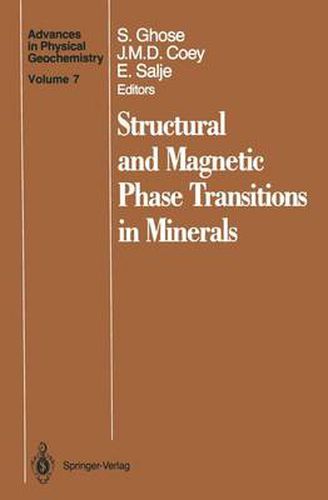Readings Newsletter
Become a Readings Member to make your shopping experience even easier.
Sign in or sign up for free!
You’re not far away from qualifying for FREE standard shipping within Australia
You’ve qualified for FREE standard shipping within Australia
The cart is loading…






This title is printed to order. This book may have been self-published. If so, we cannot guarantee the quality of the content. In the main most books will have gone through the editing process however some may not. We therefore suggest that you be aware of this before ordering this book. If in doubt check either the author or publisher’s details as we are unable to accept any returns unless they are faulty. Please contact us if you have any questions.
Phase transitions in minerals are of interest to a wide spectrum of scientists - geolo- gists, mineralogists, solid state chemists, and physicists. We have now reached the point where mean field theory or Landau Theory of phase transitions as a function of temperature, pressure, or chemical composition can be usefully applied to natural materials, resulting in an improved understanding of the thermodynamics of signifi- cant constituents of the earth. Given the chemical complexity of so many silicate solid solutions, there are two distinct approaches to the problems posed by common minerals: one is to con- centrate on model compounds which could be synthetic analogs or natural end- members; the other is to work on typical minerals, with all the disorder and inhomogeneity that this implies. Model compounds provide the elements needed to build up a realistic understanding of the thermodynamic behavior of natural inor- ganic materials in all their complexity. In the first part of the book, a number of papers are devoted to structural phase transitions in quartz, Na-and Ca-feldspars, MgSi0 perovskite, and PbI , where Landau Theory and lattice and molecular 3 2 dynamics have been used to explain or predict thermodynamic behavior. A different thermodynamic approach has been used to understand phase separation and atomic ordering in solid solutions such as olivines, pyroxenes, rhombohedral carbonates and oxides. E. Salje (Chapter 1) applies the Landau Theory for the second-order phase transi- tion to the feldspar end-members albite, NaAlSi0 , and anorthite, CaAlSi0 .
$9.00 standard shipping within Australia
FREE standard shipping within Australia for orders over $100.00
Express & International shipping calculated at checkout
Stock availability can be subject to change without notice. We recommend calling the shop or contacting our online team to check availability of low stock items. Please see our Shopping Online page for more details.
This title is printed to order. This book may have been self-published. If so, we cannot guarantee the quality of the content. In the main most books will have gone through the editing process however some may not. We therefore suggest that you be aware of this before ordering this book. If in doubt check either the author or publisher’s details as we are unable to accept any returns unless they are faulty. Please contact us if you have any questions.
Phase transitions in minerals are of interest to a wide spectrum of scientists - geolo- gists, mineralogists, solid state chemists, and physicists. We have now reached the point where mean field theory or Landau Theory of phase transitions as a function of temperature, pressure, or chemical composition can be usefully applied to natural materials, resulting in an improved understanding of the thermodynamics of signifi- cant constituents of the earth. Given the chemical complexity of so many silicate solid solutions, there are two distinct approaches to the problems posed by common minerals: one is to con- centrate on model compounds which could be synthetic analogs or natural end- members; the other is to work on typical minerals, with all the disorder and inhomogeneity that this implies. Model compounds provide the elements needed to build up a realistic understanding of the thermodynamic behavior of natural inor- ganic materials in all their complexity. In the first part of the book, a number of papers are devoted to structural phase transitions in quartz, Na-and Ca-feldspars, MgSi0 perovskite, and PbI , where Landau Theory and lattice and molecular 3 2 dynamics have been used to explain or predict thermodynamic behavior. A different thermodynamic approach has been used to understand phase separation and atomic ordering in solid solutions such as olivines, pyroxenes, rhombohedral carbonates and oxides. E. Salje (Chapter 1) applies the Landau Theory for the second-order phase transi- tion to the feldspar end-members albite, NaAlSi0 , and anorthite, CaAlSi0 .